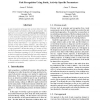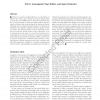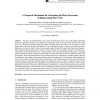187 search results - page 16 / 38 » Discovering Temporal Features and Relations of Activity Patt... |
PAMI
2011
13 years 2 months ago
2011
—The field of Action Recognition has seen a large increase in activity in recent years. Much of the progress has been through incorporating ideas from single frame object recogn...
CVPR
2001
IEEE
14 years 9 months ago
2001
IEEE
A gait-recognition technique that recovers static body and stride parameters of subjects as they walk is presented. This approach is an example of an activity-specific biometric: ...
JOCN
2010
13 years 2 months ago
2010
Studies in semantics traditionally focus on knowledge of objects. By contrast, less is known about how objects relate to each other. In an fMRI study, we tested the hypothesis tha...
JCNS
2000
13 years 7 months ago
2000
The phase relationship between the activity of hippocampal place cells and the hippocampal theta rhythm systematically precesses as the animal runs through the region in an environ...
ECCV
2008
Springer
14 years 9 months ago
2008
Springer
Abstract. The use of sparse invariant features to recognise classes of actions or objects has become common in the literature. However, features are often "engineered" to...



